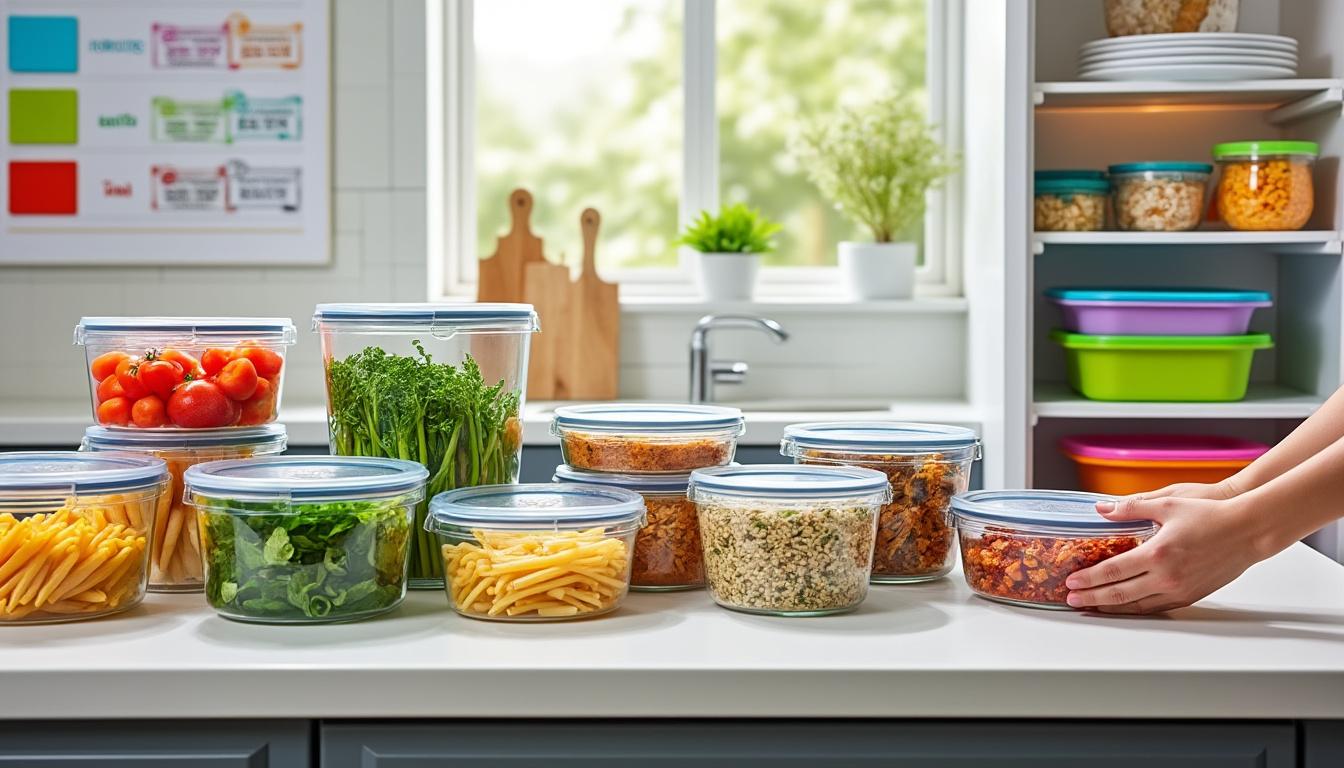In an era marked by soaring grocery prices and rising awareness of sustainability, mastering the art of storing leftovers correctly has never been more essential. Nearly 30% to 40% of the food supply in the U.S. alone is wasted, significantly impacting both household budgets and the environment. From preventing contamination to extending freshness, effective leftover storage practices enable consumers to maximize meal value, reduce food spoilage, and ultimately help conserve natural resources. Leveraging the right containers—from Tupperware and Pyrex to airtight options like Glasslock and Ziploc—combined with strategic refrigeration and freezer techniques, food waste can be drastically curtailed without sacrificing convenience or quality. This article presents a comprehensive approach to leftover management, catering to a modern, professional lifestyle that values efficiency and sustainability.
Essential Food Safety Principles for Proper Leftover Storage
Food safety is a cornerstone of effective leftover storage. Improper handling or storage can result in bacterial growth and foodborne illness, issues that no consumer wants. The USDA advises keeping perishable foods at temperatures under 40 degrees Fahrenheit to slow bacterial activity. Equally important is the “2-Hour Rule”: foods left out at room temperature beyond this period become unsafe, particularly in warmer conditions where this window shrinks to just one hour.
Every kitchen should incorporate routine practices to mitigate risks:
- Store leftovers promptly—transfer cooked food to airtight containers within two hours of cooking.
- Maintain refrigerator temperatures at or below 40°F, and freezers at 0°F or below to prolong freshness and prevent spoilage.
- Wrap foods airtight to retain moisture and block airborne contaminants; products like Rubbermaid and Snapware offer reliable seals that protect contents effectively.
- Divide large portions into shallow containers (ideal Tupperware or Bento Box style) to accelerate cooling and reduce the risk of bacterial growth.
Leftover management strategies also recommend discarding any food that has been refrigerated for more than four days or shows signs of spoilage such as off odors, discoloration, or slimy textures. Relying on sensory evaluation alongside refrigeration timelines offers balanced judgment on food safety.
| Storage Timeframe | Refrigerator (40°F or below) | Freezer (0°F or below) |
|---|---|---|
| Cooked Meats & Poultry | 3-4 days | 2-6 months |
| Cooked Vegetables | 3-5 days | 2-3 months |
| Soups & Stews | 3-4 days | 2-3 months |
| Dairy Products (opened) | 3-5 days | Not recommended |
| Fresh Cut Fruits | 3-5 days | Not recommended |
Understanding these storage durations and adhering to them helps safeguard health while reducing unnecessary food wastage. Choosing the right tools like Pyrex glass containers can combine durability with safety; their non-porous nature prevents lingering bacteria and odors.
Best Practices for Cooling and Handling Leftovers
Rapid cooling is vital to minimize the time food spends in the temperature danger zone (40°F-140°F) where bacteria thrive. Breaking down large food batches into smaller amounts accelerates this process. Using heavy-duty freezer bags like Ziploc or vacuum sealers such as FoodSaver effectively remove air, further limiting bacterial growth.
Before sealing leftovers, let hot foods cool uncovered in the refrigerator briefly but not exceeding 30 minutes. This prevents condensation buildup in containers which can promote spoilage. Also, rotate leftovers regularly to consume older items first, as part of the FIFO (First In, First Out) methodology.
Optimizing Storage for Different Food Categories to Extend Freshness
Each type of food has unique storage requirements. Tailoring storage techniques to food categories not only prolongs shelf life but preserves flavor and texture.
Dairy Products: Extending Shelf Life Without Compromising Quality
Dairy demands cold and consistent conditions. The ideal temperature range is between 32°F and 38°F; every 5°F increase above this speeds up spoilage by nearly 50%. Storing milk, yogurt, and cheeses away from the fridge door into colder interior sections is essential.
Hard cheeses wrapped in foil or stored within airtight Pyrex or Glasslock containers maintain moisture without encouraging mold. Meanwhile, ice cream should always be kept in the main compartment of the freezer rather than its door to avoid repeated partial thawing and refreezing, which can degrade its texture and safety.
- Store dairy in original packaging when possible to minimize exposure.
- Use airtight containers like OXO or Rubbermaid for leftovers to prevent odor transfer.
- Don’t leave dairy out longer than necessary to avoid rapid temperature fluctuations.
Meat, Fish, and Poultry: Preventing Cross-Contamination and Spoilage
Given the higher risk associated with meats and seafood, their storage requires strict measures:
- Store raw meat on the bottom shelf in leakproof containers or sealed Rubbermaid storage to catch drippings and prevent cross-contamination.
- Keep meat temperatures low, ideally in a drawer set to approximately 29°F.
- Never refreeze meat once thawed, as this can compromise quality and safety.
- Freeze meat in FoodSaver vacuum bags or use Snapware airtight containers to stave off freezer burn and preserve taste.
Detailed planning to consume meats within appropriate timeframes further reduces food loss. Always check packaging dates and use leftover meats quickly to prevent spoilage.
| Meat Type | Refrigerator Life | Freezer Life |
|---|---|---|
| Raw Poultry | 1-2 days | 9-12 months |
| Cooked Poultry | 3-4 days | 4-6 months |
| Beef (steaks, roasts) | 3-5 days | 4-12 months |
Leveraging Kitchen Tools and Storage Solutions for Maximum Efficiency
Using the appropriate storage systems can dramatically influence the freshness and usability of leftovers. From airtight containers to vacuum sealing systems, the market offers solutions suited to various needs and preferences.
Comparing Popular Storage Options: Tupperware, Pyrex, Glasslock, and More
| Container Type | Material | Pros | Cons |
|---|---|---|---|
| Tupperware | Plastic | Lightweight, durable, airtight | Can stain, may retain odors |
| Pyrex | Glass | Non-porous, microwave/oven safe, dishwasher safe | Heavy, breakable |
| Glasslock | Glass with airtight seals | Odor resistant, airtight, durable | Heavier and pricier |
| Snapware | Plastic & glass options | Varied sizes, good seals | Some plastic variants stain |
| Bento Box | Plastic | Compartmentalized, portable | Limited capacity |
Vacuum sealing products such as FoodSaver systems effectively extend freezer life and reduce waste by eliminating air. Silicone alternatives like reusable Ziploc-style bags offer eco-friendly flexibility, making them a preferred choice in 2025 kitchen toolkits.
Labeling and Organizing Leftovers for Time-Saving and Waste Reduction
Labeling is an often overlooked but critical component. Writing contents and storage dates directly on containers with masking tape or using dedicated fridge labels supports the FIFO method and prevents forgotten leftovers from spoiling unnecessarily.
- Create a fridge inventory and rotate items regularly.
- Use clear containers like Glasslock or OXO for easy identification.
- Group leftovers by type to streamline meal planning.
Practical Tips and Creative Solutions to Avoid Food Waste With Leftovers
Proper leftover management goes beyond storage kitchenware; it also involves creative utilization and meal planning to minimize the chance of food becoming waste.
Creative Ways to Repurpose Leftovers and Save Money
- Transform leftover vegetables into frittatas, quiches, or hearty soups, revitalizing their appeal and increasing nutritional intake.
- Use leftover cooked grains and pasta in salads or stir-fries to introduce variety and freshness.
- Bento Boxes serve as great lunch solutions for portion control and utilizing assorted leftovers creatively.
- Host a “leftovers night” weekly to encourage finishing stored food before spoilage.
Implementing systematic meal planning using inventory management apps can further aid in reducing waste, offering personalized recipe suggestions based on available ingredients. For more advises on budgeting and efficient cooking, consult resources like budget grocery shopping guides and kitchen hacks that save time and money.
Long-Term Storage and Freezing Strategies to Safeguard Leftovers
Freezing leftovers is a proven method to expand their lifespan significantly. However, best practices must be applied:
- Cool foods completely before freezing to prevent condensation and ice crystals.
- Use airtight containers or vacuum seal bags like FoodSaver to maintain texture and flavor.
- Label each item with contents and freezing date to avoid confusion and waste.
- Thaw leftovers safely by refrigerating overnight or using cold water baths; microwave thawing is recommended only if reheating immediately.
Proper packaging techniques help avoid freezer burn—a quality killer that alters food taste and texture—thus ensuring meals retain their freshness until consumption.
| Food Type | Freezing Duration | Tips for Freezing |
|---|---|---|
| Soups and Stews | 2-3 months | Cool completely, use freezer-safe airtight containers |
| Cooked Meats | 2-6 months | Vacuum seal or wrap tightly to prevent freezer burn |
| Cooked Pasta and Rice | Up to 3 months | Divide in small portions for quick thawing |
Smart Refrigerator Organization to Maximize Shelf Life of Leftovers
Maximizing refrigerator space with the correct organization promotes food longevity and easy access, reducing waste. Learn to optimize your refrigerator zones effectively:
- Upper shelves: Store ready-to-eat meals and leftovers here, maintaining temperatures around 38°F to 40°F.
- Bottom shelves: Reserve for raw meats or products needing the coldest environment, ideally around 32°F to 38°F.
- Crisper drawers: Use humidity-controlled settings to store fresh fruits and vegetables properly.
- Door shelves: Best suited for condiments and non-perishables, avoiding highly perishable items due to temperature fluctuations.
Utilizing storage containers like Snapware or OXO that are transparent and airtight enhances visibility and seals in freshness. Regularly cleaning your fridge is also critical to prevent odor build-up and maintain optimal hygiene.
| Fridge Section | Temperature Range | Recommended Food Types |
|---|---|---|
| Upper Shelves | 38-40°F | Leftovers, deli meats, cooked foods |
| Bottom Shelves | 32-38°F | Raw meat, poultry, fish |
| Crisper Drawers | Varies by humidity control | Fresh produce |
| Door Shelves | Varies, warmest area | Condiments, juices |

